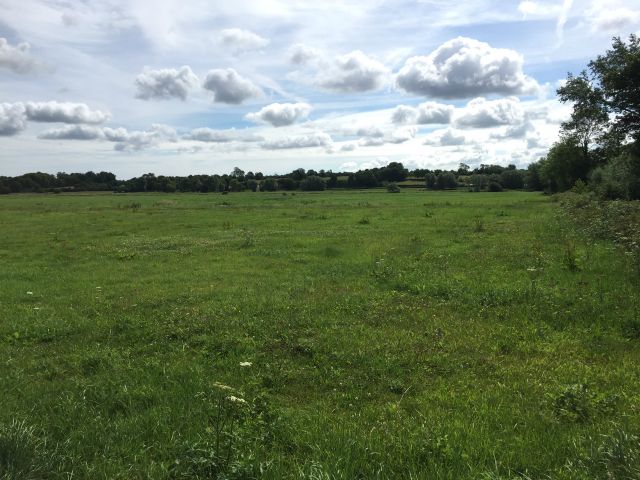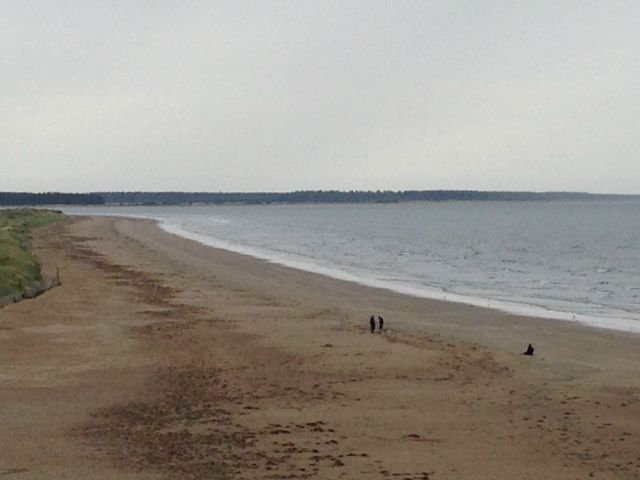For our final morning in Normandy we drove back over to the Cotentin and picked up where we left off the previous evening. First stop was the site of the terrible battles that took place near and around a little bridge over the Merderet River. The LaFiere Causeway was an elevated road that ran between Utah Beach and Ste. Mere-Eglise. A German garrison was stationed on the other side of St Mere Eglise and they were desperately trying to make their way over to Utah while the paratroopers were tasked with preventing them. Both sides of the causeway had been flooded and the road was the only way for troops and vehicles to move in that area. A series of battles took place over the course of several days with the Allies finally prevailing. Go there today and you only hear the bellow of cows.

The manor and bridge at LaFiere Causeway. The scene of fierce fighting in the days following the invasion.

Lucky paratroopers dropped into dry fields similar to these. Luckier still were the ones who fell into fields with cows since they knew those weren’t mined. Many unlucky ones fell into fields flooded by the Germans and under the weight of their gear drowned in 2-3 feet of water.

Can’t believe this is the only picture we got of Norman hedgerows. They are on the left side of the street and can be taller and even more impenetrable than these. The D-Day planners made a grave mistake in not respecting these obstacles more. It took weeks to break out of them following the invasion. As many or more were killed fighting in the hedgerows as in the invasion itself. The Norman’s refer to the hedgerows as “Bocage”.
The most remote place we might have visited was way back a one lane road in the hedgerows to a place called Timmes Orchard where 150 paratroopers held out for a couple of days against great odds. We also stopped somewhat off the beaten path at a German cemetery where over 10,000 are buried. We visited a cow field that served as one of the first huge temporary cemeteries long before the formal final cemeteries were built. And another field where the first temporary airfield was built in occupied France. In my research I had even accidentally come across the location of a World War I dirigible hangar that is huge and still sits out in a Norman field in the middle of nowhere and we checked it out.
Our next to last stop in Normandy was the little town of Ste. Mere-Eglise where there is a large museum dedicated to the Airborne operations. It was here that a paratrooper’s chute got stuck on the church steeple and so many were shot in their chutes as they floated down into the village center as shown in The Longest Day. In fact a good bit of the movie was shot here. It is perhaps the most famous hamlet of the entire invasion area.

The famous church at Ste-Mere Eglise. If you look closely you can see the paratrooper caught on the steeple.

After the war when the blown out stained glass was replaced appreciative villagers made sure the replacement included paratroopers along with the Madonna & Child.

Restored C47 like ones used to ferry paratroopers over Normandy. This one is in the Airborne Museum in Ste-Mere Eglise.

Restored Horsa glider in Airborne Museum. Hundreds of these ferried troops, jeeps, anti-tank guns, etc. into Normandy. Many troops were killed when these crash landed into the Hedgerows.
Before leaving Normandy we dropped back by Bayeux and toured the famous Bayeux Tapestry. It is a thousand year old tapestry commemorating William The Conqueror’s victory at the Battle of Hastings. It is a continuous piece of cloth 20 inches tall and 230 feet long and is a wonderful piece of art. How it survived intact over 9 centuries is amazing. If you are ever in the area you should see definitely see it.
We left Normandy late afternoon headed back to Paris. I was glad to get our car safely back to the Paris airport that evening. We then caught the train into the city finally getting to our hotel around 10PM.
Headed out for dinner at a one of countless sidewalk cafes each brimming with very late night diners. Walked over to the Seine and then back to the hotel and finally got to bed well after midnight.

Latenight dinner at sidewalk cafe our first night in Paris. Had a great chopped steak, frites, salad & desert.
































